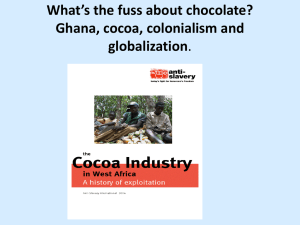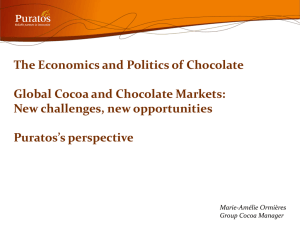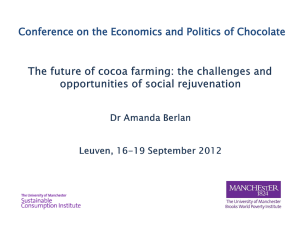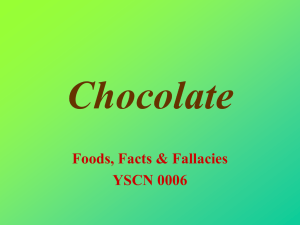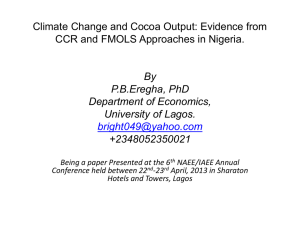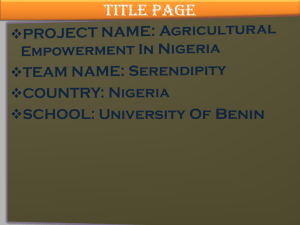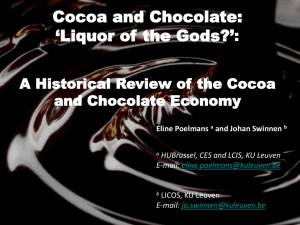Cook and Tell
advertisement
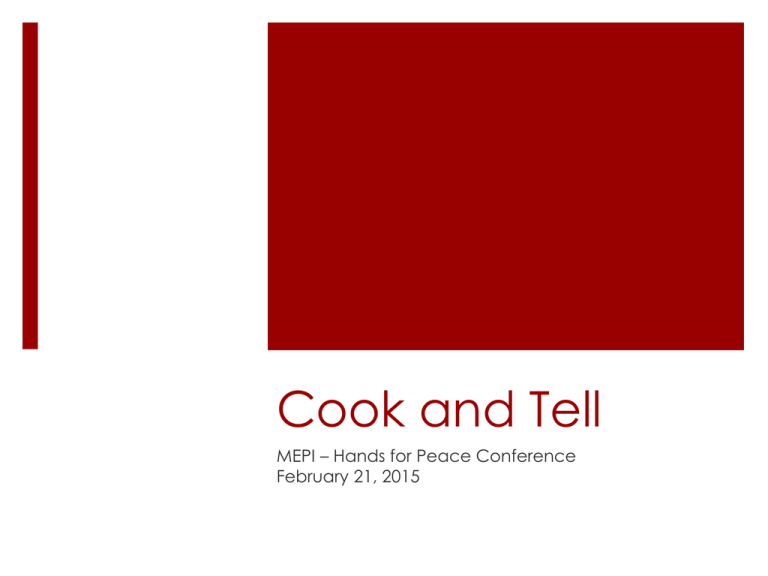
Cook and Tell MEPI – Hands for Peace Conference February 21, 2015 Montessori Curriculum Connections Math: measurement, capacity, volume, less, more, greater than, less than, etc. Science: chemical reactions when you add heat, mixtures, solutions, viscosity, properties of matter, etc. Geography: biomes, habitats, mapping, continents, oceans, landforms, kingdom, phylum, class, family, genius, species, parts of a plant, types of trees, weather, etc. Today’s Goal To introduce you to electric cooking technologies that allow you to cook in the classroom with relative ease and clean up To show you fun and interesting ways to talk about the Montessori elementary curriculum, while cooking with students. For you to leave with the tools and language to cook and tell in your classroom. Today’s Concepts Foods used throughout history Where foods are grown and how Growing, harvesting, and using nature’s foods Health, fitness, and nutrition Food History Child friendly resources Child friendly resources Stories about food Stories about food Internet resources Internet resources Preparing to Cook Make: aprons oven mitts pot holders table cloths cloth napkins Get students working together Get students communicating Get students creating Easy Aprons on Pinterest Make pot holders Make cloth napkins Make quilt tablecloths Preparing to Cook What will you cook? How? Name the Montessori curriculum connections you could make in math, science, and geography Choose your curriculum connections Gather the cooking equipment and ingredients Gather the cooking supplies – bowls, utensils, cups, napkins, etc. Get ready to tell a story, while cooking What you need to know Where foods are grown and how they grow? How do we harvest food? How do we make the foods we buy in the grocery store? The process of digestion, absorption, energy, and waste. What is the purpose of food? What does society use chocolate for? Collect Student’s Prior Knowledge Make a KWL chart or a Know/Need to Know chart Make a Connections/Observations/ Wonderings chart Collecting students prior knowledge will help students connect to the lesson. Students will feel more motivated to listen and participate if they fee as if they are a part of the story. Key Lesson One: Chocolate Chocolate dates back to 1500 B.C. Chocolate is made from the cocoa bean. The cocoa bean is the fatty seed of Theobroma cacao. Theobroma cacao is a small evergreen tree native to tropical regions of Central and South America. The seeds of this tree are used to make cocoa mass, cocoa powder, and chocolate. The scientific method STOP and introduce or reinforce the scientific method before continuing You could have a chart near you or you could name the steps with the children, depending on their level of understanding You could even ask one student to be the scribe and record the method for future reference Language Teachable Moment Describe the cocoa pod to the students using descriptive language in a complete sentence. The cocoa pod has a rough and leathery rind. It is approximately 3 centimeters thick or 1.2 inches thick. The pod is filled with sweet pulp. It contains 30 to 50 large seeds depending on its size. The seeds are soft and white to a light purple color. When the seeds dry they become reddish brown in color. Rare varieties of white cocoa remain white when dry. Science Teachable Moment The cacao tree may have originated in current day Columbia and Venezuela. Wild cacao still grows in these regions of the world. This is a great opportunity for a mapping lesson and cardinal direction mini lesson. The cocoa bean was a common currency in Mesoamerica before the Spanish conquest. Upper el students may enjoy discussions about the Spanish colonization of the Americas. Trade Religion Disease 1492 and other conquistadores Key Lesson One: Chocolate Harvesting the cocoa seeds to make chocolate Each cocoa pod is typically opened with a machete. The pulp and cocoa seeds are removed. The rind is discarded. The pulp and seeds are piled in heaps, placed in bins, or laid out on grates for several days. This process is called “sweating,” where the thick pulp liquefies as it ferments. When the pulp liquefies the seed/beans can be harvested easily. A typical pod contains 20 to 50 beans and about 400 dried beans are required to make one pound of chocolate. Cocoa pods weigh an average of 400 grams or (0.88 lbs.) Math Teachable Moment Word Problem: If Ms. Sarah’s classroom had 3 cocoa pods each containing 30 seeds and Ms. Amber’s classroom had 2 large cocoa pods with 50 seeds. How many more cocoa pods would they need to make one pound of chocolate? No Bake Cookies Examine the ingredients with students: ½ cup agave nectar/honey 1/3 cup cocoa powder ¼ cup unsweetened almond milk ¼ cup coconut oil ¼ cup almond butter 2 cups oats 1/3 cup shredded coconut ½ teaspoon vanilla extract 1/8 teaspoon salt Recipe Mix together agave and cocoa powder. Heat over medium heat until combined. Stir in almond milk and coconut oil and bring to a boil. Continue stirring and boil for one minute. Remove pan from heat and stir in almond butter, oats, coconut, vanilla extract, and salt. Using a spoon or cookie scoop, drop cookies onto cookie sheets or wax paper. Place cookies in the refrigerator for at least 20 minutes before serving. Language teachable moment Ask students to parse the recipe. Ask students to parse just the verbs. Ask students to generate ingredients they could substitute for: Agave Almond milk Almond butter Free write Take out a piece of paper or your MEPI notepad. When I say go you are going to write for 2 minutes, without lifting your pencil from your paper. The goal is to brain dump what you have learned, so far, about using food and cooking to compliment and reinforce the Montessori curriculum. Key Lesson Two: Waffles Ingredients: 2 eggs 2 cups all-purpose flour 1 ¾ cups milk ½ cup vegetable oil 1 tablespoon white sugar 2 teaspoons baking powder ¼ teaspoon salt ½ teaspoon vanilla extract Eggs Flour Wheat flour is a powder made from the grinding of wheat. Durum wheat or macaroni wheat is a tetraploid wheat, having 28 chromosomes. Durum wheat was created by artificial selection of emmer wheat formerly grown in Central Europe and the Near East. Durum wheat Waffles Recipe Preheat waffle iron. Beat eggs in large bowl until fluffy. Add flour, milk, vegetable oil, sugar, baking powder, salt and vanilla, just until smooth. Spray preheated waffle iron with non-stick cooking spray. Pour mix onto hot iron and cook until golden brown (5 minutes) Lesson Three: Spinach/Basil Pesto Ingredients: Spinach Parmesan Cheese Salt Pepper Lemon Rind (optional) Olive Oil Garlic Walnuts Preparing your cooking lesson Which ingredient from the spinach/basil pesto will you choose to be your focus? Suggestions: Basil Spinach Olive oil Salt How is each above ingredient grown, harvested, processed? Where does it grow? What is the story of the peoples who live in this place? Be ready to share nutritional facts and information about the body and how we digest foods and convert foods in order to have energy and ultimately, life. Consider the historical significance of each ingredient. Think about my examples in math, science, and geography as well as what students are currently studying. Choose what curricular connections you want to make, while cooking. Remember in a key lesson you want to leave out some information to enable students’ independent research. Resources Pinterest – for easy to make aprons, pot holders, quilt tablecloths, etc. Wikipedia, Google scholar, Discus, Choosemyplate.gov – for facts about chocolate, wheat, and basil. There are book resources on slides 5- 9 as well. IF POSSIBLE USE PRIMARY RESOURCE DOCUMENTS WHEN TEACHING STUDENTS NEW INFORMATION. When researching the history of food I found it challenging to find primary resource documents. In the future, I would contact an area librarian and ask for his or her expertise in order to get better quality resources for the factual data. Presenter Contact Information Nathalie Hunt nhunt@coastalmontessoricharter.or g Currently serves as the director of Coastal Montessori Charter School. Coastal Montessori Charter School is located in Pawleys Island, SC. The school serves ages 6 – 12. It is soon to expand through middle school in a building being build by USDA funds, since charter schools do not receive facilities funding. Credentials: BS in Human Development from Cornell University; PhD from UT Austin; Lower Elementary Montessori Certificate; K – 6 NYS Teacher Certification; 12 years experience in the field of education If you are interested in learning more about Coastal Montessori Charter School visit our website at: Coastalmontessoricharter.org We also have a beautiful commercial on Youtube: Coastal Montessori Charter School New employment opportunities coming soon at Coastal Montessori!
